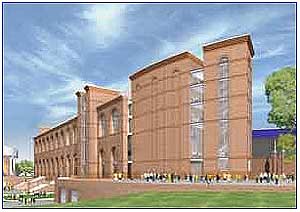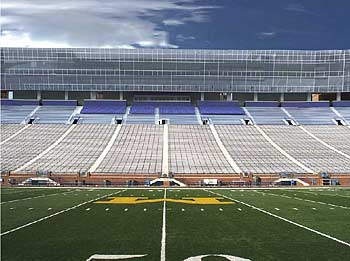
One of Metro Detroit's largest landmarks is about to get much bigger now that plans for the expansion of Michigan Stadium have been finalized.
 The University of Michigan's Board of Regents approved the plans for The Big House (Michigan Stadium's nickname), which call for a total of 500 new seats for a total capacity of 108,000. Among the new amenities are 83 luxury suites, 3,2000 club seats, expanded restrooms and concession stands, along with a new stately brick façade on the structure's east and west sides. Construction is set to finish in time for the 2010 football season without interrupting any home games.
The University of Michigan's Board of Regents approved the plans for The Big House (Michigan Stadium's nickname), which call for a total of 500 new seats for a total capacity of 108,000. Among the new amenities are 83 luxury suites, 3,2000 club seats, expanded restrooms and concession stands, along with a new stately brick façade on the structure's east and west sides. Construction is set to finish in time for the 2010 football season without interrupting any home games.
The $226-million project has created some uproar from fans and alumni who don't want to see luxury suites or club seats integrated into Michigan's traditional egalitarian bench seating. Groups such as Save the Big House have risen up to fight the expansion plans, comparing them to ill-conceived halo around the stadium in the late 1990s that was eventually removed. A group of disabled veterans has also filed a lawsuit against the university because of the plans, saying it doesn't provide enough wheelchair seating.
 But the university is pressing forward with the project, claiming it will greatly enhance the experience for fans in one of college football's most sacred places. University officials point out that there will be wider aisles, more handrails, additional exit and entry points for improved crowd circulation, along with more handicapped seating. It will also will upgrade the structure's utilities, mechanical and electrical systems.
But the university is pressing forward with the project, claiming it will greatly enhance the experience for fans in one of college football's most sacred places. University officials point out that there will be wider aisles, more handrails, additional exit and entry points for improved crowd circulation, along with more handicapped seating. It will also will upgrade the structure's utilities, mechanical and electrical systems.
However, the biggest difference will be in appearance. The 400,000-square-foot expansion includes two multi-story masonry structures on both the field's east and west sides. The level of the stadium bowl will stand 10 feet higher than the highest point of the current scoreboards. The new design will also direct more crowd noise onto the field. There will also be two smaller buildings at the north and south end zones that house additional restrooms and concessions and support functions, such as first-aid, security and will-call.
Private donations and Athletic Department resources, primarily revenues generated by the new seating, will cover the renovation's $226-million price tag. Stephen M. Ross, one of the nation’s premier real estate developers, recently gave $5 million to the project through The Michigan Difference, the university’s $2.5 billion fundraising campaign.
Once the project is paid for, University officials expect Michigan Stadium's new seating to help fund facility upgrades and other costs of 25 men’s and women’s varsity sports.
 Michigan Stadium is not only one of sports' classic and most widely recognized facilities, it is also the largest football stadium in the world. It has been the home to some of the most celebrated moments in college football history, such as Michigan's stunning 1967 upset over Ohio State that launched the career of legendary coach Bo Schembechler, Desmond Howard striking the Heisman pose in 1991 and UofM's crushing win over Ohio State in 1997 that cemented Charles Woodson as the first defensive player to win the Heisman Trophy.
Michigan Stadium is not only one of sports' classic and most widely recognized facilities, it is also the largest football stadium in the world. It has been the home to some of the most celebrated moments in college football history, such as Michigan's stunning 1967 upset over Ohio State that launched the career of legendary coach Bo Schembechler, Desmond Howard striking the Heisman pose in 1991 and UofM's crushing win over Ohio State in 1997 that cemented Charles Woodson as the first defensive player to win the Heisman Trophy.
Legendary University of Michigan football coach and athletic director Fielding Yost led the charge to build the stadium in the early1920s. Although he envisioned a facility that could seat between 100,000 and 150,000 fans, the $950,000 stadium opened in 1927 with a capacity for 72,000. It steadily expanded to its present size of 107,501. The one extra seat is reserved for Yost.
On football Saturdays the stadium will normally hold 111,000 with players, coaches, officials and band members. It maintains the record (112,118) for largest crowd at a North American stadium for a game against hated arch rival Ohio State in 2003.
Source: University of Michigan
Writer: Jon Zemke, University of Michigan, class of 2000
Enjoy this story?
Sign up for free solutions-based reporting in your inbox each week.